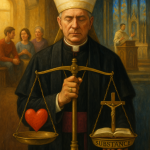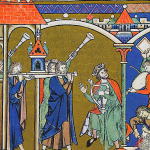Last updated on: August 27, 2016 at 6:23 pm
By
CNA Daily News
Bogotá, Colombia, Aug 27, 2016 / 12:23 pm (CNA/EWTN News).- Just as God trusts us and expects us to change, we must treat others “never based on fear but on the hope God has in our ability to change,” Pope Francis said in Saturday remarks that rejected the despair of a fractured culture. “Which will it be: hope for change, or fear?” the Pope asked a gathering of Catholic leaders Aug. 27. “The only thing acting out of fear accomplishes is to separate, to divide, to attempt to distinguish with surgical precision one side from the other, to create false security and thus to build walls.” By contrast, acting on the basis of hope for change and conversion is something that “encourages and incites.” He said hope “looks to the future, it makes room for opportunity, and it keeps us moving forward.” Fear-based action bespeaks guilt and punishment, while action based on the hope of transformation “bespeaks trusting, learning, getting up, constantly trying to generate new opportunities.” The Pope’s words came via video message to Bogota, Columbia, where the Celebration of the Extraordinary Jubilee of Mercy drew participants from all the countries of South America. Over a dozen cardinals and more than 120 bishops registered for the event, as did rectors of national Marian shrines, religious superiors, and directors of associations and new ecclesial communities. The event aims to show the communion of the churches of the Americas. It was jointly organized by the Pontifical Commission for Latin America and the Latin American Episcopal Council. Pope Francis said he was pleased that all the countries of America were taking part. “Given the many attempts to fragment, divide and set our peoples at odds, such events help us to broaden our horizons and to continue our handshake; a great sign that encourages us in hope,” he said. The Pope repeated his previous lamentations of a fragmented, throwaway culture, a culture that is “tainted by the exclusion of everything that might threaten the interest of a few.” “A culture that is leaving by the roadside the faces of the elderly, children, ethnic minorities seen as a threat,” he said. “A culture that little by little promotes the comfort of a few and increases the suffering of many others. A culture that is incapable of accompanying the young in their dreams but sedates them with promises of ethereal happiness and hides the living memory of their elders. A culture that has squandered the wisdom of the indigenous peoples and has shown itself incapable of caring for the richness of their lands.” “We live in a society that is bleeding, and the price of its wounds normally ends up being paid by the most vulnerable,” he added. “But it is precisely to this society, to this culture, that the Lord sends us. He sends us with one program alone: to treat one another with mercy. To become neighbors to those thousands of defenseless people who walk in our beloved American land by proposing a different way of treating them.” The Pope’s remarks drew on St. Paul’s First Letter to Timothy. “Paul minces no words: Jesus Christ came into the world to save sinners, of whom Paul considers himself the worst,” the Pope explained. “He is clearly aware of who he is, he does not conceal his past or even his present. But he describes himself in this way neither to excuse or justify himself, much less to boast of his condition.” “For all our sins, our limitations, our failings, for all the many times we have fallen, Jesus has looked upon us and drawn near to us. He has given us his hand and showed us mercy,” he continued. “All of us can think back and remember the many times the Lord looked upon us, drew near and showed us mercy. All those times that the Lord kept trusting, kept betting on us. “ The Pope encouraged his audience to concentrate on remembering their sin, not their alleged merits, and to grow in “a humble and guilt-free awareness of all those times we turned away from God – we, not someone else, not the person next to us, much less that of our people – and to be once more amazed by God’s mercy.” Mercy is not simply a beautiful word. It is a concrete act of drawing close to others and making them feel that “the last word has not yet been spoken” in their lives. These people must be treated in such a way “that those who feel crushed by the burden of their sins can feel relieved at being given another chance.” “Paul’s God starts a movement from heart to hands, the movement of one who is unafraid to draw near, to touch, to caress, without being scandalized, without condemning, without dismissing anyone. A way of acting that becomes incarnate in people’s lives,” the Pope added. The way of mercy can seek what is best for the other person “in a way they can understand.” He noted the action of the merciful father in the Parable of the Prodigal Son. He said that Christians are sometimes tempted to be scandalized, like the older son in the parable who begrudged his father’s mercy towards his wayward brother. “We might be scandalized that he did not upbraid him but instead treated him for what he was: a son,” the pontiff continued. Pope Francis suggested this is due to “spiritual Alzheimer’s,” which is “when we forget how the Lord has treated us, when we begin to judge and divide people up.” “We take on a separatist mindset that, without our realizing it, leads us to fragment our social and communal reality all the more,” he said. “We fragment the present by creating ‘groups’. Groups of good and bad, saints and sinners.” What made St. Paul a disciple was “the trust God showed in him despite his many sins.” If we have the best plans, projects and theories about what to do, but lack mercy, “our pastoral work will be cut off midway.” He questioned whether the bishops teach the path of showing mercy in their pastoral plans, parish structures, seminaries, missionary activity, clergy meetings and theology. “Today we are asked especially to show mercy to God’s holy and faithful people – they know a lot about being merciful because they have a good memory –, to the people who come to our communities with their sufferings, sorrows and hurts,” the Pope exhorted. “But also to the people who do not come to our communities, yet are wounded by the paths of history and hope to receive mercy.” “Mercy is learned, because our Father continues to forgive us. Our peoples already have enough suffering in their lives; they do not need us to add to it,” the Pope said. “To learn to show mercy is to learn from the Master how to become neighbors, unafraid of the outcast and those ‘tainted’ and marked by sin. To learn to hold out our hand to those who have fallen, without being afraid of what people will say. Any treatment lacking mercy, however just it may seem, ends up turning into mistreatment.” Pope Francis encouraged the Catholic cardinals, bishops, and other leaders to be grateful that God “trusts us to repeat with his people the immense acts of mercy he has shown us.” Read more
















